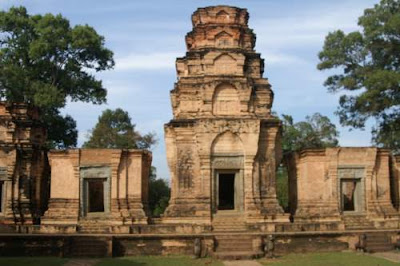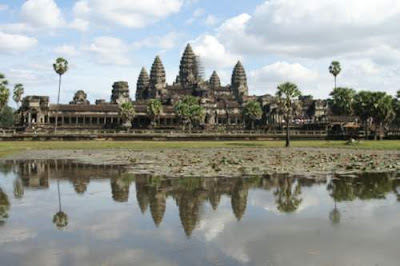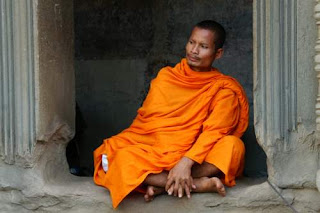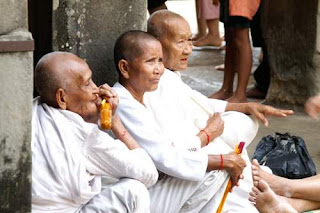 Dear Gentle Reader,
Dear Gentle Reader,We all come from somewhere, and that somewhere provides each of us with special advantages or challenges.
If you are born in Darfur, you are very likely not reading this. Be born into the British Royal Family, and you have different opportunities and challenges to those of a millwright's son born in Port Huron, Michigan.
As it is with people, so it is with countries.
Spain had huge forests of sea-worthy hardwood timber. They harvested and converted these forests into vast navies. The Spanish were then lucky enough to find lands rich in silver and gold held by people poor in armaments in the New World.
The Khmer people of historical Cambodia were also fortunate.
Cambodia is, largely, very flat as you can see from the picture at the top.
Anyone coming from the Canadian prairies, the American Midwest, the Netherlands, or Northern Germany, would feel at home there. Well, apart from the heat and the humidity. (Pretty much 35°C and 90% humidity for our visit.)
The heart of the Ancient Khmer homeland is modern Cambodia, and it was just as flat then as it is now.
Cambodia has two main rivers, the Mekong River, which snakes through South East Asia, and the Tonlé Sap River. The Tonlé Sap River drains the Tonlé Sap (a large lake) into the Mekong River.
Wait--that's not right...
Half the year the Tonlé Sap River drains the lake into the Mekong River while the other half of the year sees the reverse--the Tonlé Sap River fills the lake with water from the Mekong River...
Because Cambodia is so very flat, when the monsoons, the great seasonal rainstorms, arrive they dump vast quantities of water on the land. But, being flat, the land does not drain well; there is nowhere for the excess water to go.
Brimming with excess water, the lake swells overs its banks and sends water flooding down the Tonlé Sap River.
At the same time, however, the Mekong River takes up the excess water from a much more massive portion of South East Asia, and the Mekong River overflows too... ..the Mekong River overflows up the Tonlé Sap River.
This means that Tonlé Sap, the lake, regularly overflows it length and breadth and becomes four times larger, or more, yearly.
This flooding, caused by water laden with silt flowing with the Mekong River from all of South East Asia, meant that there was phenomenal irrigation and fertilization of the Tonlé Sap on a yearly basis.
This flooding would not be good if you grew wheat or barley, but it is phenomenally valuable for growing rice. Over time, one rice species thrived whose stalk can grow up to 1 meter (3 feet) in one day, to keep up with the pace of flooding in the lake.
Other things that grow well in lakes are fish. And, when the water recedes and the lake becomes smaller and shallower, harvesting those surplus fish is also quite easy.


The Khmer people were blessed with a heartland that provided them with not only a constant, substantive diet, but one rich in protein that did not require much work to harvest. This allowed them to focus their activities on other things.
The historical, architectural Khmer kingdom that people come to see in Cambodia essentially started with Jayavarman II, whose reign was from 790 AD to 835 and ended 25 kingships later when Jayavarman Paremesvara took power in 1327.
For the Euro-centrics amongst us, what does the time frame 790 to 1327 cover?
In 790, Emperor Constantine VI was installed as Emperor in Byzantium. The great schism in Christianity is still 264 years away (from 790 AD) but the Council of Nicea is already three years old. The monastery on the Holy Island of Lindisfarne will be sacked by Vikings in three years. The Vikings will then move onto Scotland for the first time the following year and start to pillage Ireland another year later.
OK, what about the end of the Khmer reign?
In 1327, Edward II of England will be deposed by the Archbishop of Canterbury and poor Edward II will, later that year, be murdered in Berkeley Castle. In two years Charlemagne's dynasty will peter out and the House of Valois will start to rule France. In three years Frederick of Austria will die and Louis IV of Bavaria will ascend the throne of the Holy Roman Empire. Most importantly, to your scribe, in 1330, William of Occam will suggest that the simplest solution is best (Occam's Razor).
So, back to Cambodia and to the sodden Khmer people with tons of food due to the annual flooding of their land.
When food is not a problem and your people have wet feet and not so much to do, the simplest solution is to build, apparently.
The Khmer people started a building regime that climaxed with the reign of Suryavarman II from 1113-1150.
There was mud all around the Khmer people, because of the silting from the monsoon-driven flooding. So, initially, the Khmer people took that mud and made bricks which they built temples with.

They would then carve those bricks to create figures in bas-relief like this figure of the Hindu god Vishnu riding his mount, the magical garuda, half woman, half bird--visually a bit like a harpy from European mythologies.

 The Khmer also found stone under their feet.
The Khmer also found stone under their feet. When they dug deep enough, they encountered a spongy stone called laterite. When wet, laterite was soft and malleable. It could be cut like a big slab of peat and slowly lifted out of the sodden ground, or out of a river basin.
Once the water had drained out of the porous laterite, it dried in the sun and became a stone suitable for foundations or for infill for walls. It was far too porous to be sculpted, but was a good base to lie finely carved sandstone upon.
The image above is a wall made of laterite at the Ta Prohm complex built by King Jayavarman VII (1181-1220).
At East Mebon, below, kids played amongst the foundations of the raised temple. Around the laterite blocks are finer sandstone blocks.

Climbing to the top of East Mebon, built in the reign of King Rajendravarman (944-968), we see, on top of the laterite foundations, brick constructions again.

Many consider the pinnacle of Khmer architecture to have been created during the reign of Suryavarman II who reigned from 1113-1150. (In this period the Knights of the Hospital of St. John formally resolved to fight for the Holy land and the University of Paris was founded.)
Suryavarman II built structures like Angkor Wat which became a city, a royal palace, and a state temple dedicated to Vishnu, the Preserver among the ruling triumvirate of gods (Brahma, Vishnu, and Shiva) of the Hindu pantheon.
At Angkor Wat the laterite foundations are not visible and bricks were not used. Here the foundations are covered and the visible stones are all finely carved sandstone.
This is the heart of the Angkor Wat complex built by Suryavarman II.

It is still visited by monks,

and nuns,

even though they are Buddhist and this temple is dedicated to a Hindu god, Vishnu.
The corridors of Angkor Wat

are famous for their massive depictions of battle scenes and stories.



And that is all for today. I will be back with more.
I am flying to France today, and my cache of postings was used up by the Cambodia trip, so there may be a brief pause in postings.
Scroll down to see links to other MTM postings for this week.
I am flying to France today, and my cache of postings was used up by the Cambodia trip, so there may be a brief pause in postings.
Scroll down to see links to other MTM postings for this week.
Tschuess,
Chris
Junosmom of Lifetime Learning on behalf of Travis Erwin.
As an aside, Pattinase has a first class story published here yesterday... on David Cranmer's e-zine Beat to a Pulp









6 comments:
Thanks so much, Chris. So kind of you to say that.
I will have a brief MTM post tomorrow.
My post is up, Chris. I'll be back later to read :-)
Very fine post you have on history, Chris.
Actually my MTM post is now up, on the cholera pandemic of 1832 in Toronto. So, I'm special, I have two.
Chris, bon voyage!
I enjoyed your post and look forward to hearing about France.
Back to read your post and it's amazing. You are Cambodia's voice and camera on the Internet.
Wow, Chris: This piece belongs in a classy travel mag, really. Thanks. The coridors of Ankor Wat are now part of my mind's architecture. Thanks for MTM pick-up. Enjoy France, Mon Ami. aloha-
Post a Comment